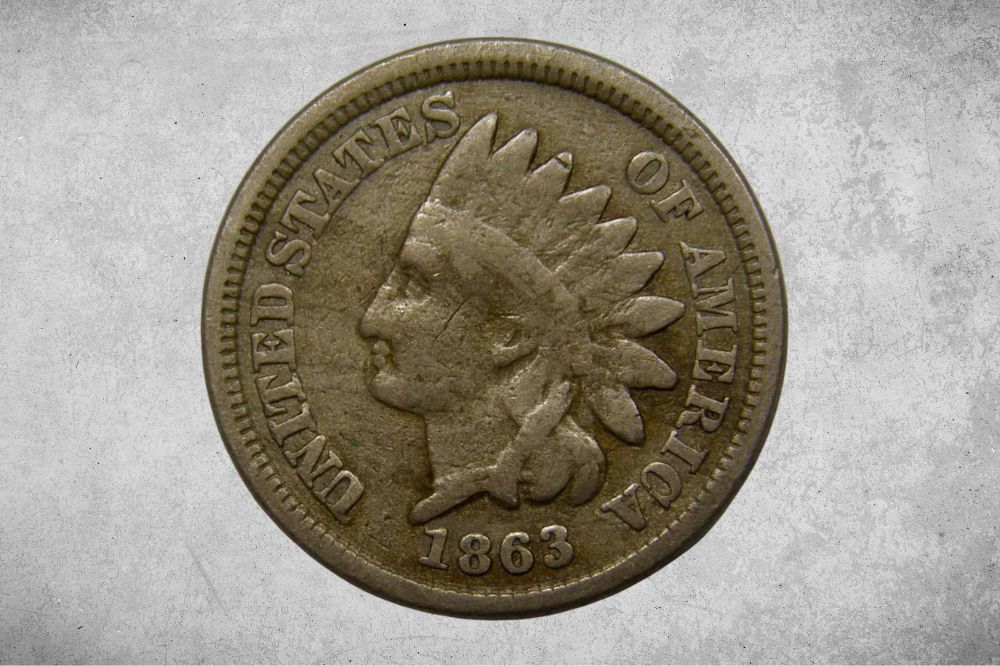Are you a coin enthusiast seeking information about the 1863 Indian Head Penny value? You’re in luck because we have put together a review that covers everything you need to know about this coin, including its history, value chart, errors, and varieties.
The 1863 Indian Head Penny is a popular coin struck solely at the Philadelphia Mint. Despite its face value of only $0.1, this coin can be worth thousands of dollars to collectors, especially those interested in the proof strike counterparts. Keep reading to learn more about the 1863 Indian Head Penny and its value in today’s market.
1863 Indian Head Penny Value Details
- Category: Indian Head, Shield Reverse
- Mints: Philadelphia
- Total Mintage: 49,840,460
- Obverse Design: Native American in Full Headdress
- Reverse Design: A Laurel Wheat around the ONE CENT inscription
- Designer: James B. Longacre
- Composition: 0.880 Copper; 0.120 Nickel
- Diameter: 19 mm (0.74 inches)
- Mass: 4.67 grams
- Edge: Plain
1863 Indian Head Penny Value Chart
So what is the value of an 1863 Indian head penny? Here’s the price guide data from the Greysheet website to help you determine this coin’s value in today’s market.
|
1863 Indian Head Penny Value Chart |
|||||
| Mint Mark | MS63 | MS64 | MS65 | MS66 | MS67 |
| 1863 No Mint Mark Indian Head Penny Value |
$536 |
$715 |
$1,550 |
$3,120 |
$22,500 |
|
1863 Indian Head Penny Proof |
|||||
| 1863 No Mint Mark Indian Head Proof Penny Value |
$998 |
$1,800 |
$2,850 |
$6,000 |
$17,300 |
| 1863 No Mint Mark Indian Head Proof Penny Value (CAM) |
$1,280 |
$1,950
|
$4,500 |
$10,000 |
$33,600 |
| 1863 No Mint Mark Indian Head Proof Penny Value (DCAM) |
– |
– |
$24,000 |
– |
– |
1863 Indian Head Penny Value and Varieties Guide
1863 No Mint Mark Indian Head Penny Value
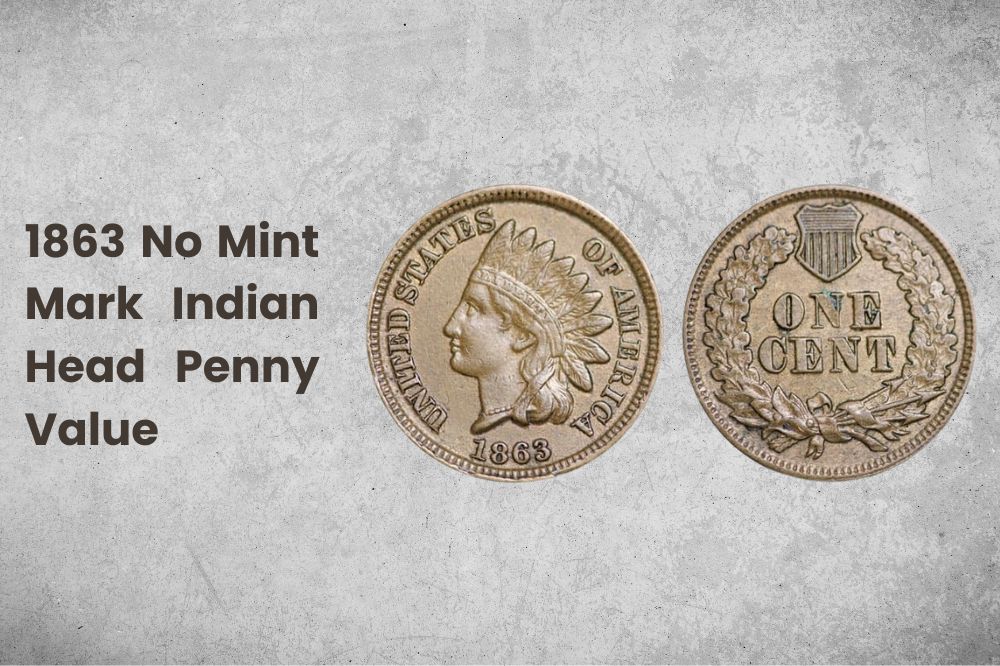
- Type: Indian Head, Shield Reverse
- Edge: Plain
- Mint mark: None
- Place of minting: Philadelphia
- Year of minting: 1863
- Face value: $0.1
- $ Price: $536to $22,500
- Quantity produced: 49,840,000
- Designer: James B. Longacre
There was no mint mark in all 1863 Indian Head Penny minted. It was because it was solely struck at the Philadelphia Mint, so you will not see any variety of it with D or S mint mark.
The face value of the 1863 Indian Head Penny is just $0.1, but of course, that’s not what it’s worth to collectors, especially considering that the lowest grade of this coin variety could be sold for more than $500. The highest and most recently sold 1863 Indian Head penny value was $20,400 at an auction held by Heritage Auctions in 2021 and was graded as an MS67 by PCGS.
Now, if you’re not familiar with coin grading, MS67 means that the coin was basically in near-perfect condition. It had minimal flaws and was well-preserved for a coin over 150 years old!
1863 No Mint Mark Proof Indian Head Penny Value (CAM/DCAM)
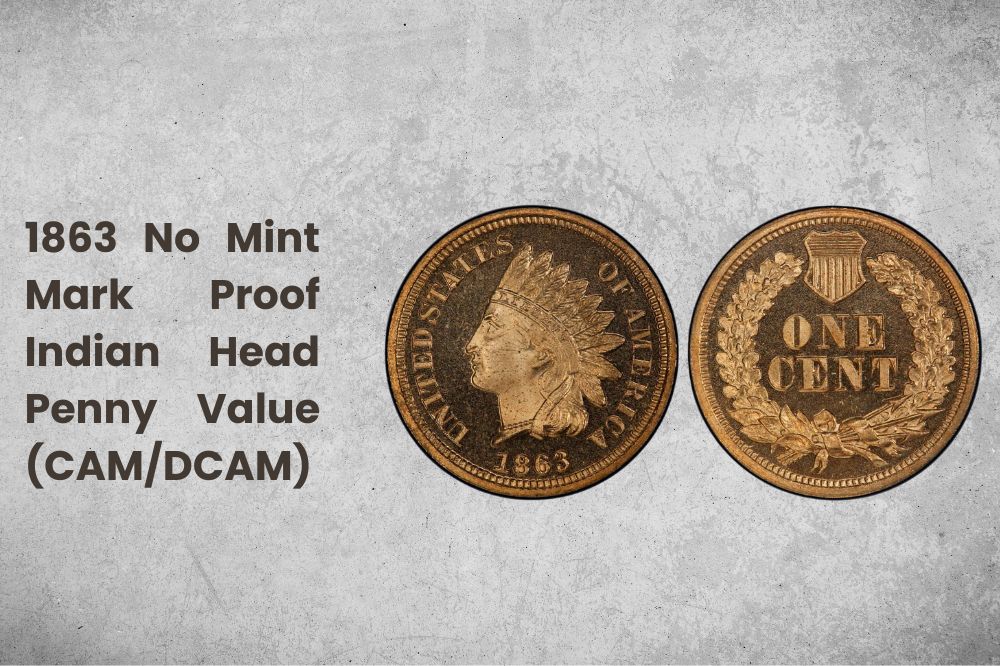
- Type: Indian Head, Shield Reverse
- Edge: Plain
- Mint mark: None
- Place of minting: Philadelphia
- Year of minting: 1863
- Face value: $0.1
- $ Price: $998to $33,600
- Quantity produced: 460
- Designer: James B. Longacre
If you think the business strike 1863 Indian Head Penny’s worth is way too much, wait until you learn about its proof strike counterpart. The lowest grade is worth over $900!
According to the Greysheet website, two 1863 Indian Head Proof pennies were sold at auction for very high prices. The first one was sold in 2019 at the Stack’s Bowers Auction House. This particular coin is known as the Snow-PR1 and is a Proof 65 Deep Cameo, which means it’s in exceptional condition. It was certified by PCGS, a leading grading service in coin collecting. This coin ended up selling for $16,800!
The second 1863 Indian Head penny was sold a couple of years prior, on April 6th, 2017, at Heritage Auctions. This coin was also graded a PR65 Deep Cameo by PCGS, and it sold for $15,275. While it didn’t quite reach the same price point as the first one, it’s still an impressive amount for a penny!
Also Read: Top 15 Most Valuable Indian Head Penny Worth Money
1863 Indian Head Penny Value History
The Indian Head cent or Indian Head Penny was a coin struck in Philadelphia Mint in 1859 to replace the Flying Eagle design. The creator, James B. Longacre, was the United States Mint Chief Engraver. The coin showed a woman called Miss Liberty wearing a feathered headdress. However, the headdress did not accurately show how some native peoples wore their head adornments.
According to the US Coins and Jewelry article, it was believed that the “Indian Head” portrait on an 1863 P Indian Head Penny Value was not actually modeled after a Native American but after Sarah, the daughter of James Barton Longacre. She visited her father at the mint and tried on Sitting Bull’s Indian headdress, inspiring her father to sketch her and create the image for the coin.
Some people think that the portrait actually depicts Lady Liberty on a headdress. The coin was popular and helped to reinforce the popularity of small-sized cents. The metal in each coin was worth less than one cent, but the 1863 Civil War Penny showed that even small, low-value coins could be hoarded.
In addition, the Indian Head Penny was used for 50 years and had different versions. The 1859 Indian cent was only made for one year and had no shield on the back. The coin’s design and makeup did not change much after 1864. The most popular rare date is the 1877 Indian cent. Only 852,500 of these coins were made. The 1909 S Indian cent is the rarest coin, with only 309,000 pieces produced, and it was the second coin in the series to be mint-marked.
In 1863, there was a shortage of silver coins in Philadelphia, causing the demand for cents to rise by 20%. To solve the problem, merchants issued one-cent metal tokens, which were widely accepted, and the government introduced fractional currency. James Pollock, the Mint Director during the Lincoln Administration, suggested replacing the copper-nickel cent with a bronze one of the same size because people only wanted base metal money for convenience.
In addition to this, nickel was causing damage to machinery, so it should be eliminated as a coinage metal. The 1863 Copper-Nickel Indian Cent became the most common type of coin in the series and is widely available at an affordable price. On December 8th, the Mint Director proposed a bronze cent and a two-cent piece to the Treasury Secretary.
Thus, the 1863 Indian cent has the highest mintage among copper-nickel cents from 1860 to 1864 and is easily available in circulated and MS64 conditions. But it is more challenging to find in MS65 or higher than its earlier counterparts. The coin usually has a good strike and ranges in luster and color from bright and frosty to duller and more subdued.
1863 Indian Head Penny Value Grading
The 1863 Indian Head Penny value is highly dependent on its condition, from good to uncirculated, and of course, the uncirculated coins are the most valuable. The condition assessment is based on thoroughly evaluating the key design elements, such as the edges of feathers, hair, headband, cheek, and neck.
Coins that exhibit little wear and are classified as mint or extremely fine are deemed to be of higher worth than those that show moderate wear, categorized as fine or good. However, despite the wear, the historical significance of the 1863 Indian Head Penny retains its value in the market, making it a prized possession in any collection.
List of 1863 Indian Head Penny Value Errors
1. 1863 Indian Head Penny Struck Through Error
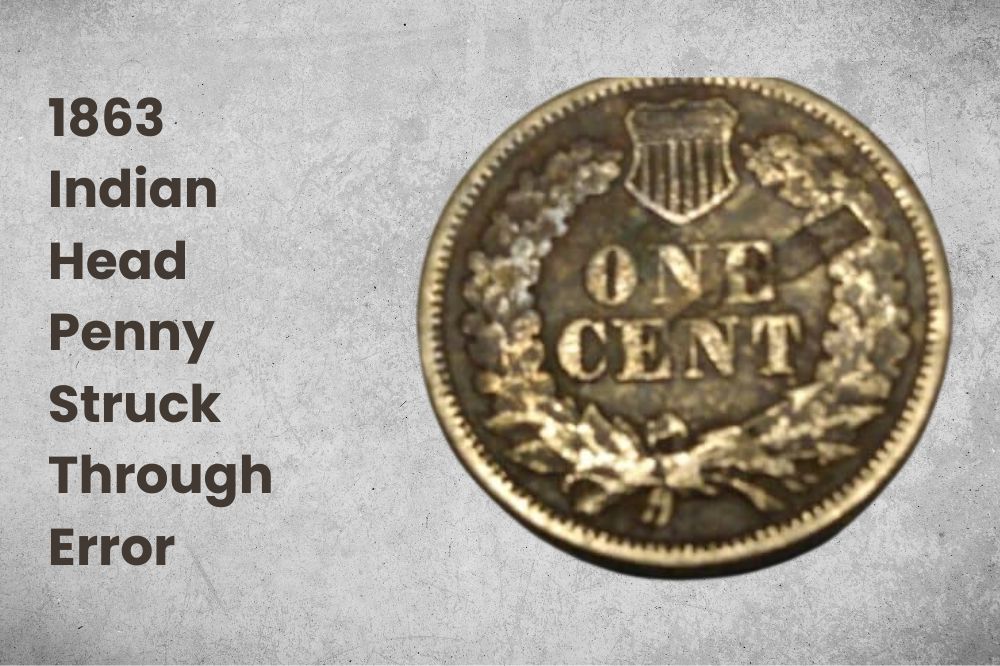
This 1863 Indian Head penny error occurs when a foreign object gets between the die and the planchet during the striking process. The result is an impression of the foreign object or even another coin being struck into the penny’s surface. The 1863 American Indian Head Penny value will depend on the severity of the error and the object that caused it to occur. So, if you come across 1863 Indian Head Penny varieties with a dramatic struck-through mistake, it could potentially increase its value among collectors.
2. 1863 Indian Head Penny Die Cap Error
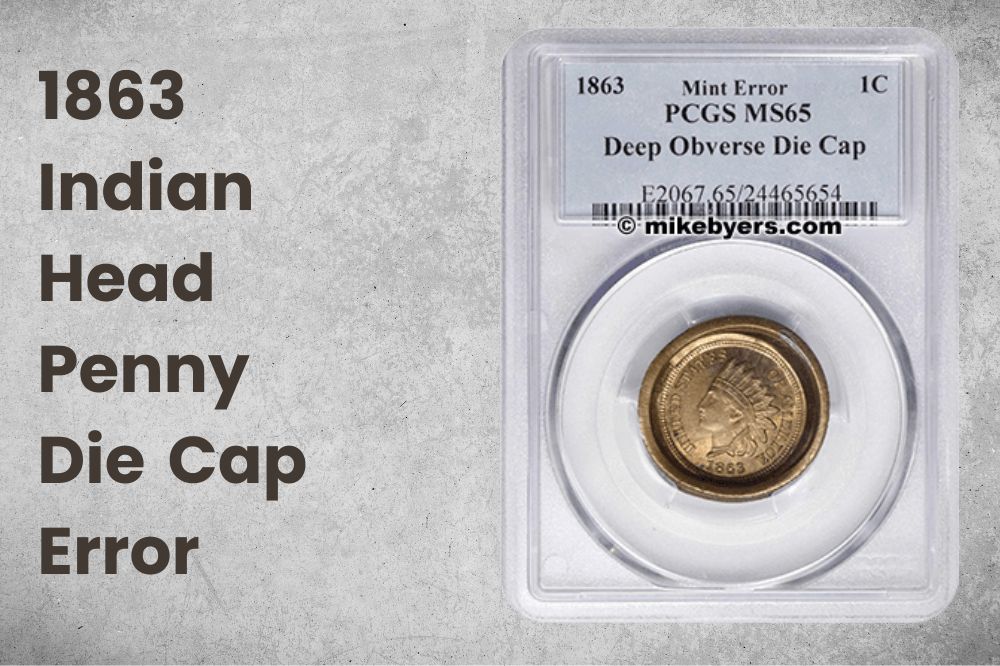
According to Coin World, an 1863 Indian Head Penny (MS65) with a unique mistake known as a “deep obverse die cap” was sold at Stack’s Bowers auction in 2020 for $18,000. The error happened when the penny got stuck in the machine and was hit multiple times, making it bigger and deeper than other pennies.
As a result, the writing on the other side appeared very large and surrounded by many leaves. The cataloger emphasized that this penny is exceptional and a great opportunity for the value of an Indian head penny dated 1863.
3. 1863 Indian Head Penny Off-center Error
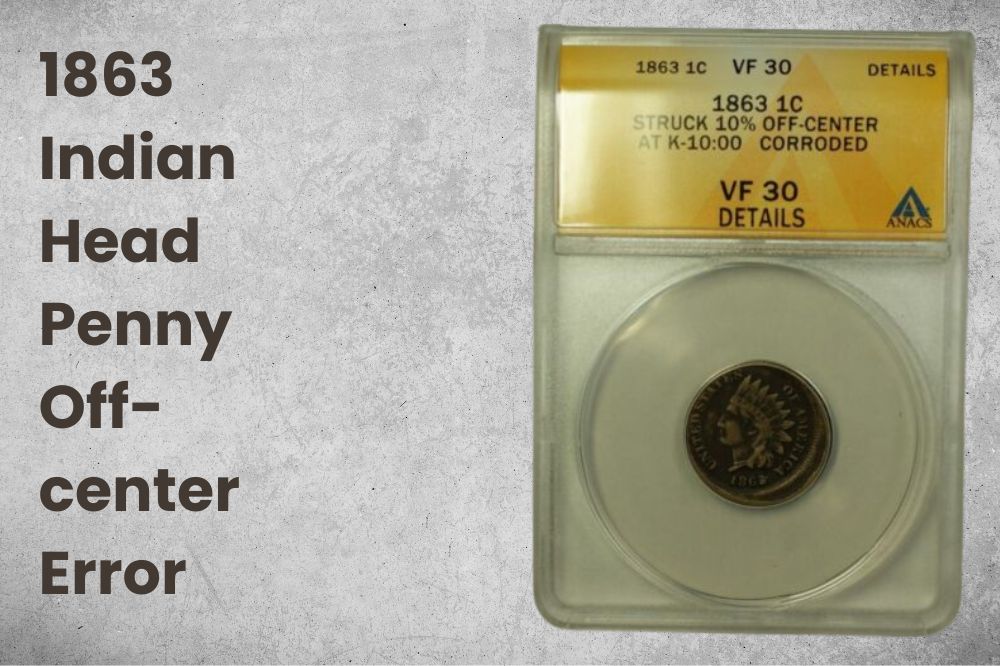
An 1863 Indian Head Penny value with a significant off-center error is $350. This particular 1863 Indian Head Penny error caused the coin to be struck 10% off-center, which means the coin’s design appears to be shifted 10% to the left of its intended position.
Another one with the same error is at 15% off center, worth $495. Off-center errors can happen when coins are minted, and it occurs when the die cap used to strike the coin is not placed correctly. This leads to the coin being struck in a position that is not in the center, resulting in an off-center error. These errors can range from minor displacements to significant ones, like in the case of the 1863 Indian Head Penny value.
4. 1863 Indian Head Penny Cud Error
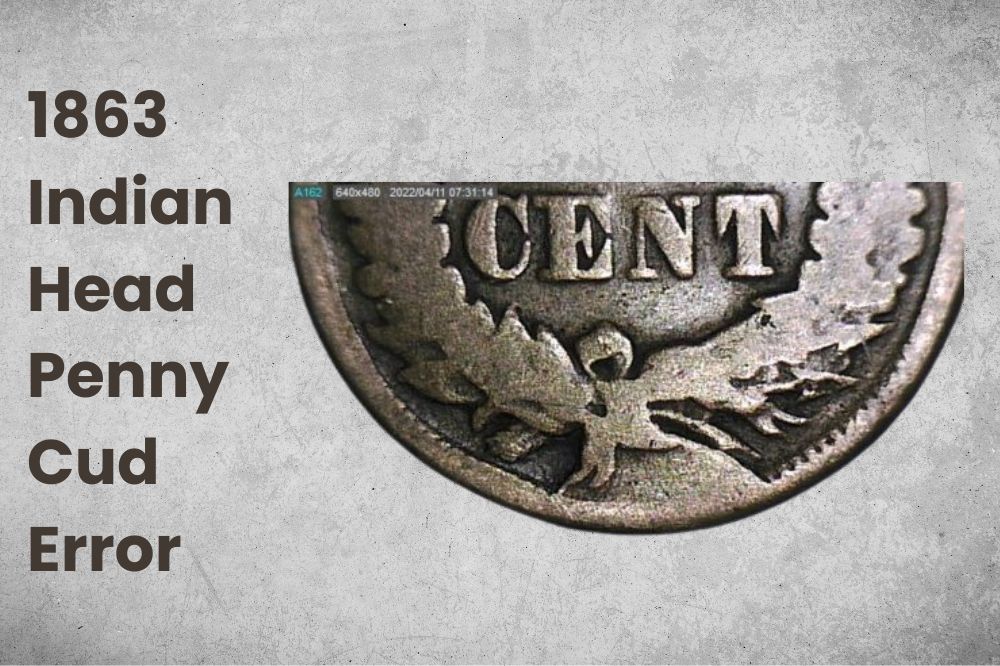
A “cud” on a coin is a damaged area on the edge that looks like a blob. It happens when a small piece of the die breaks away during minting and can have various shapes. As for the 1863 Indian Head Penny, a prominent cud is located at the upper left corner of the reverse side. Most cuds happen spontaneously during production, while some are caused by impacts.
5. 1863 Indian Head Penny Broadstruck Error
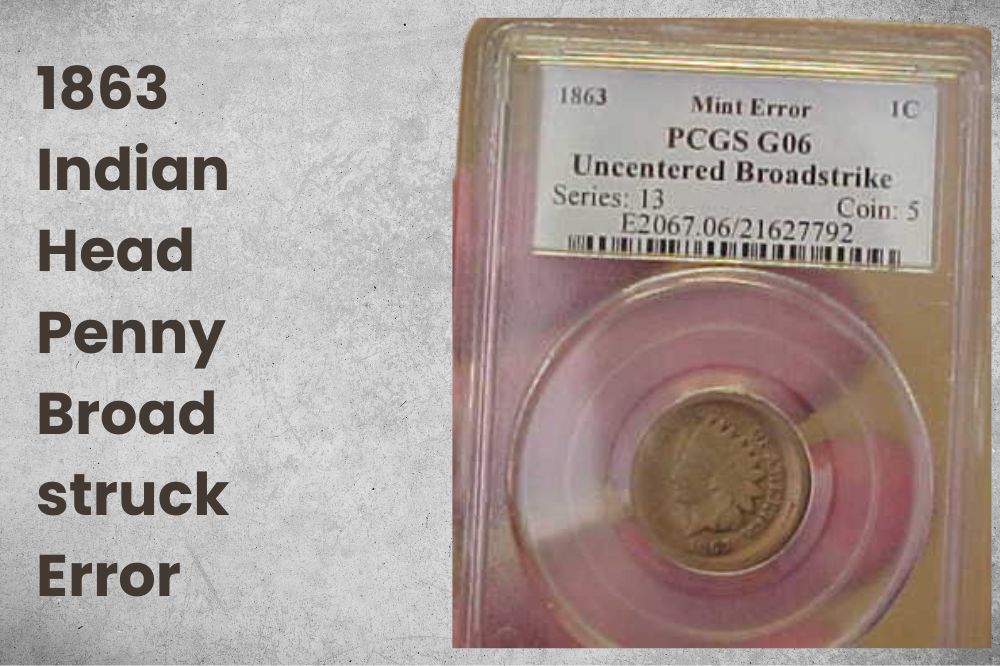
An 1863 Indian Head Penny broadstrike error happens when a coin is made without the collar that forms its rim and edge. This makes the coin bigger than usual. Some may mistake this error as off-center, but it’s important to note that there is a difference between a broadstruck coin and an off-center coin.
The main difference lies in how much of the original design remains on the coin after striking. If all of the design, including the rim and denticles, are present on the coin, it is considered broadstruck. If the design is off-center but still intact, it is considered an off-center coin.
Here is a video of the most valuable 1863 Indian Head Penny varieties sold at higher prices at some auctions due to their errors.
1863 Indian Head Penny Value FAQs
Q1: What is an 1863 Indian Head Penny Not One Cent?
That one from 1863 is not a coin but a Civil War token privately produced by merchants during a time of coin shortage. It was used for everyday transactions and features the year 1863 on the front with an image of an Indian Head, some historical figures, and the words “Not One Cent” on the back with a wreath design. Congress outlawed the production of these tokens in 1864.
Q2: Where is the mint mark on a 1863 Indian Head Penny?
The 1863 Indian Head Penny has a total of 49,840,460 mintage (both business and proof strike). All of it was struck at the Philadelphia Mint, which meant that the Indian head penny dated 1863 has no mint mark.
Q3: What is a 1863 penny made of?
The 1863 Indian Head Penny is a popular item among collectors because of its distinctive composition, consisting solely of a copper-nickel alloy (88% copper and 12% nickel) utilized exclusively during the Civil War. These coins are highly sought after because they are heavier than other variations of the Indian Head Penny.
Q4: Is a 1863 penny rare?
While high-quality versions of 1863 Indian Head Penny are rare or those in MS65 Grade, lower-quality versions can still be obtained easily. This coin usually has a good strike and comes in many different colors and levels of shine.
